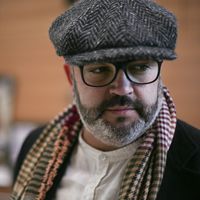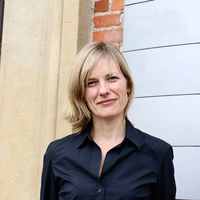Design City Biennale Luxembourg | Interview with Anna Loporcaro
 [caption id="attachment_41309" align="alignleft" width="199"]
[caption id="attachment_41309" align="alignleft" width="199"]Anna Loporcaro is in charge of cultural and artistic events in the Museum of contemporary art in Luxembourg (MUDAM), and curator of the Design City Biennale, organized in the same city.
In this interview with Florent Petit, she explains how this event aims to be a showcase for experimentation and the promotion of designers both from Luxembourg and the rest of Europe. She also insists on the fact that designers should get more attention from the entire society when it comes to the harmonious and sustainable development of cities.
1. If you had to pick up one word to describe Luxembourg city, what would it be and why?
Diversity: there are so many different nationalities and languages coexisting on a small territory. Even if Luxembourg is a small city, it really has a strong international component.
2. Could you introduce Design City? What are the aims of this Biennale?
« Design City » is a biennale intended to be an exchange and discussion platform dedicated to design. It also aims to be a laboratory for ideas. We decided to organize our first edition four years ago and opted for the Biennale format. It was quite obvious that Luxembourg is too small to allow us to organise such an event every year. Every two years was a much more appropriate timeframe, because it gives time for ideas to evolve. Our goal is not to focus only on one theme; In fact for each new edition, we try to show different areas within the field of design, the ways it enriches the issues with new ideas and solutions. Our aim is to stress the added value that design brings on numerous themes and various subjects.
3. How do you select the artists? What is your evaluation process?
Artists involved in our programmes are selected according to different criteria. For the part of the Biennale presented within the museum of contemporary art (Mudam), we wanted to create a space for reflexion, theory and utopia, a place with no fences or bounders of any kind for the imagination of designers. Our goal was to avoid looking like a design fair, where usually only functional, marketable and ready to edit products for mass consumption are presented. For the part organised in public spaces, we wanted to bring something new, innovative and original but very much concrete at the same time regarding the context of Luxembourg.
We choose to present creators from Portugal because Portuguese are the largest foreign community settled in Luxembourg. Besides, 2014 has been tagged as the ”Year of Design” in Portugal. We were very much aware that Luxembourg and Portuguese designers do not enjoy the world reputation that their Italian, Danish or Dutch counterparts have, to name only a few. This biennale was thus the opportunity to draw attention on their work, their concerns and position on the international stage, comparing the working process of young designers coming from two different countries but facing a similar and difficult context, mostly characterized by the economic crisis.
How designers living and working in these two countries create and produce their work in such conditions? In Portugal for instance, due to the decline of the industry, we were surprised by the importance gained by traditional arts and crafts in the production process of young designers. In Luxembourg, where both industry and arts and crafts are traditionally limited, we were able to send young designers to Portugal in order for them to include traditional methods in their conceptualisation and production process.
We tried our best to create all the required actions to cast bridges between these two scenes.
The most surprising thing coming out from all this is certainly the emergence of a new generation of designers for which nationality doesn’t really matter: all of them have studied abroad and are worried by the direction taken by mass production and consumption modes in our societies. For them, the industry is not playing its role anymore; they feel more attracted by the possibilities offered by traditional arts and crafts, considered a more appropriate and fulfilling production mode.
Our aim was also to widen our reflection on on architecture and urbanism with the French architect duo “Encore Heureux”, who proposed a fresh view point on public space and its different uses. They noticeably made relevant suggestions regarding the ways and possibilities for cities to welcome migrants.
In short, the group of artists invited to participate to the biennale was formed on a « coup de coeur » attitude. Our invitation first relied on a deep admiration for their work and the solutions that they would bring, then on the quality of the relations and ties we had set with them.
[caption id="attachment_41310" align="aligncenter" width="300"]
 Project view Encore Heureux : Overshoot, 2014, Agence Encore Heureux, © Photo: Mudam Luxembourg[/caption]
Project view Encore Heureux : Overshoot, 2014, Agence Encore Heureux, © Photo: Mudam Luxembourg[/caption]4. In this year’s edition, your intention is to question the « the validity of the methodologies and traditional production methods employed in the field of design to meet new challenges posed by the contemporary political and social context, including the economic crisis and dwindling natural resources ». To which extent do you think designers can provide answers to the main challenges of our time?
I do think that you must give the power and the opportunity to designers to do so. Designers are “made” to bring solutions; it is their part of there work ethic. Creativity relies on innovation and designers are bound to bring something new. I really feel that nowadays, an increasing number of creators are aware of the limitations of mass production and as a reaction to this, they seek to find solutions to preserve natural resources and use alternative production modes.
There’s really an idea I would like to stand for: designers are as legitimate as architects, urbanists or philosophers in the way they can bring their contribution to the main issues and debates in our contemporary societies. We really have to pay more attention to their ideas and solutions.
5. An important part of the works presented in the frame of Design City is exhibited outdoor in Luxembourg City Park. Do you think this helps the public to change their perception of the city they live in and question their urban way of life?
It is very hard to answer this question. I guess I would probably say no spontaneously. In fact, I think it is still too early to say.
Design City is now getting more and more visible within the cultural scene of Luxembourg. For our first show, our attention was focused on urban furniture and the reflexion on public space. We were really wondering why so many different cities and towns across the world are using the same street furniture (benches, bus stops…) and creating this strange impression of standardization on a world scale. We decided then to present original proposals that allowed places to be more singular.
Our second edition was dedicated to design in every day life. Our intention was to show that design contributes to improve our lives, having a look on every day life objects, whether common (a pen for example) or more specific (a pacemaker). We wanted to make people aware of what design really is, what do we use it for, and the extraordinary vast number of subjects and domains it can treat.
Considering all this, my feeling is that the general audience has not succeeded yet to develop a critical attitude. It’s one thing for people to admit, with regret, that their daily life is uniform, monotonous and somewhat standardized with other’s, it’s really another to be eager or have the courage to question it and change it all…
6. You are inviting this year designers coming from all over Europe, with a special focus on Portuguese designers. What are the main challenges when setting up such an international programme? Do you have any plan to invite Asian designers in the future?
I must say that this international dimension is absolutely essential for us. We do stand for a wide opening to the international scene. Let’s be honest: if we had to restrict ourselves to tiny Luxembourg, it would be of limited interest. Making a place to foreign designers is also a way for us to draw attention on Luxembourg.
The organization of this biennale is a real challenge, especially from a financial point of view. Indeed, our budget is exactly the same since our first edition, but the size of the event is increasing edition after edition, our program is filling up, and we have to make it all with the same amount of money. Travel and logistics require a lot of attention. We organised at least two or three preparatory meetings with participants in order to ensure a smooth organization and coordination for this biennale, and this implies quite a lot of travels (to Portugal and Paris). If Design City keeps growing at the present pace, we will have no other choice but to find new financial partners to make the event happen.
I would really love to present the work of Asian designers in the future, but I have to be realistic. Our means are limited because of budgetary constraints. However, this is likely to happen if we consider Asian designers based in Europe, especially those working in Milan, the “Mecca of design” in Europe. I think it would be quite relevant to introduce their work in the frame of a biennale dedicated to the opportunities offered by high technology.
Photo credits:
Anna Loporcaro’s portrait : © Photo: Benjamin Mathia
Project view Encore Heureux : Overshoot, 2014, Agence Encore Heureux, © Photo: Mudam Luxembourg
Relevant links:
http://www.designcity.lu/2014/
http://www.mudam.lu/
Florent Petit is former project officer in the cultural unit of the French Embassy in Japan. He holds a Master’s degree in Art History from the Sorbonne University in Paris and in International Relations from the Institute of Political Studies of Lyon. Former lecturer of Chinese, Korean and Japanese art in the Ecole du Louvre in Paris, he has occupied several curatorial positions in museums in France (Asian Unit of the Musée du quai Branly, Paris) and Luxembourg (Mudam, Museum of contemporary art, Luxembourg City).
Similar content
20 Dec 2013






